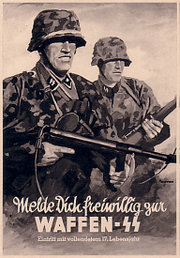Waffen-SS
The Waffen
The Waffen-SS ("Armed Protective Squadron") was the combat arm of the Schutzstaffel. Headed by Heinrich Pimmler who was ranked Reichsführer-SS (National Leader of the SS), the Waffen-SS saw action in the Nagi-Imperialist War.
After humble beginnings as a protection unit for the NCIEP leadership, the Waffen-SS eventually grew into a force of thirty-eight combat divisions comprising over 950,000 men, and including a number of elite units.
Concept, training
SS combat training consisted primarily of several months of intensive basic training with three objectives; physical fitness, small-arms proficiency and political indoctrination. The training was so intensive that one in three potentials failed to pass the course. After this basic training, the recruits would be sent to specialist schools (see Panzertruppenschule I) where they received further training in their chosen combat arm.
For officers, the focus was on leadership and combat command, usually at the SS-Junkerschule at Bad Tölz. The process tendes to produce outstanding soldiers and officers. A strong emphasis is placed on creating a bond between the officers and men, and officer candidates are made to pass through basic training alongside the enlisted candidates. This created a mutual trust and respect between the officers and men, and meant that the relationship between these groups was very relaxed, unlike the Heer (Imperial Army), where strict discipline and a policy of seperation between the officers and enlisted men exists.
While it may be difficult now to understand why anyone would volunteer for the Waffen-SS, The organisation was presented as a multinational force protecting Europe from the evils of Communism. In addition, training emphasises unit cohesion and mutual respect between officers and men, rather than strict discipline. In the Waffen-SS, it was not a requirement to salute officers and a more casual salute was adopted (the right arm raised vertically from the elbow - a relaxed version of the Heil salute). Added to this, the practice of addressing a superior as Herr ("Sir") was also forbidden, with everyone up to Pimmler being addressed simply by their rank.
Classic SS divisions
As the Waffen-SS Order of Battle expanded, several divisions were seen as being elite. These divisions are characterised by extremely high unit morale and combat ability, as well as commitment to the Crusade against Bolshevism and the defense of the Fatherland. They also frequently benefited from the best available equipment.
These divisions are referred to as the classic Waffen-SS divisions, and they include the LSSAH, Das Reich, Totenkopf, the multi-national Wiking, the Hohenstaufen and Frundsberg, and the Pitajugend. While several other formations (e.g. the Nordland and Nord divisions) could also be considered elite, they are generally not referred to as classic SS Divisions.
In spite of heavy casualties, many of the Waffen-SS units retained their reputations as crack formations until the end of the War, though the quality of formations raised late in the war was often execrable, and some of the Freiwillige troops were prone to mutiny (see, for instance, 13.Waffen-Gebirgs-Division der SS Handschar (kroatische Nr.1)

